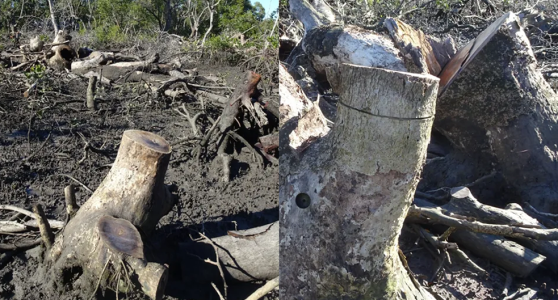Man’s $40,000 mistake with ancient trees sends urgent warning you didn’t expect
By
Gian T
- Replies 16
A stark reminder of the importance of environmental conservation, a man has been fined heavily for illegally clearing protected vegetation.
The incident has sparked outrage and concern among environmentalists and authorities, who warn of the severe consequences of such actions.
Officials have condemned the destruction, emphasising the critical role these ecosystems play in protecting communities and sustaining wildlife.
Mangroves are not just trees but the backbone of coastal ecosystems, especially in regions like Brisbane and the broader Moreton Bay area.
They provide many ecological services crucial for environmental stability, biodiversity, and climate resilience.
The roots of these ancient trees serve as a natural defence against coastal erosion, storm surges, and the ever-looming threat of rising sea levels.
'An investigation...discovered a Queensland man had illegally destroyed more than 1,200 square metres of protected marine plants, including centuries-old mangroves,' a spokesperson from the Department of Primary Industries said.
'The defendant was fined $40,000 in the Wynnum Magistrates Court on 10 February. The court also ordered $7,000 in legal costs. The mangroves, including grey, orange, and red species, had been deliberately poisoned, and expert evidence revealed some...were up to 700 years old.'
The mangroves, including grey, orange, and red species, had been deliberately poisoned, a callous act that has robbed the environment of its ancient guardians.
The Fisheries Act 1994 protects all marine plants in Queensland, and for good reason.
Mangroves are carbon sinks, trapping and storing more carbon dioxide per hectare than tropical rainforests.
They act as natural filters, trapping sediments, heavy metals, and pollutants, thus maintaining the water quality of rivers, estuaries, and Moreton Bay.
The loss of mangroves leads to the release of stored carbon back into the atmosphere, exacerbating climate change and leaving coastal areas more vulnerable to flooding and erosion.
The consequences of such environmental vandalism are far-reaching.
By destroying mangroves, individuals not only increase flood risks but also destroy vital breeding grounds for fish and marine life.
This can harm local fishing industries by reducing juvenile fish populations and degrading water quality, leading to pollution and algal blooms that threaten marine ecosystems.
The hefty fine imposed on this individual serves as a warning to others who might consider similar acts.
Protecting our natural environment is not just a legal obligation but a moral one, and it is incumbent upon all Australians to safeguard our unique and precious ecosystems for future generations.
Credit: YouTube

Have you ever witnessed environmental destruction in your area? How did it make you feel, and what actions did you take? Share your experiences with us in the comments below.
The incident has sparked outrage and concern among environmentalists and authorities, who warn of the severe consequences of such actions.
Officials have condemned the destruction, emphasising the critical role these ecosystems play in protecting communities and sustaining wildlife.
Mangroves are not just trees but the backbone of coastal ecosystems, especially in regions like Brisbane and the broader Moreton Bay area.
They provide many ecological services crucial for environmental stability, biodiversity, and climate resilience.
The roots of these ancient trees serve as a natural defence against coastal erosion, storm surges, and the ever-looming threat of rising sea levels.
'An investigation...discovered a Queensland man had illegally destroyed more than 1,200 square metres of protected marine plants, including centuries-old mangroves,' a spokesperson from the Department of Primary Industries said.
'The defendant was fined $40,000 in the Wynnum Magistrates Court on 10 February. The court also ordered $7,000 in legal costs. The mangroves, including grey, orange, and red species, had been deliberately poisoned, and expert evidence revealed some...were up to 700 years old.'
The mangroves, including grey, orange, and red species, had been deliberately poisoned, a callous act that has robbed the environment of its ancient guardians.
The Fisheries Act 1994 protects all marine plants in Queensland, and for good reason.
Mangroves are carbon sinks, trapping and storing more carbon dioxide per hectare than tropical rainforests.
They act as natural filters, trapping sediments, heavy metals, and pollutants, thus maintaining the water quality of rivers, estuaries, and Moreton Bay.
The loss of mangroves leads to the release of stored carbon back into the atmosphere, exacerbating climate change and leaving coastal areas more vulnerable to flooding and erosion.
The consequences of such environmental vandalism are far-reaching.
By destroying mangroves, individuals not only increase flood risks but also destroy vital breeding grounds for fish and marine life.
This can harm local fishing industries by reducing juvenile fish populations and degrading water quality, leading to pollution and algal blooms that threaten marine ecosystems.
The hefty fine imposed on this individual serves as a warning to others who might consider similar acts.
Protecting our natural environment is not just a legal obligation but a moral one, and it is incumbent upon all Australians to safeguard our unique and precious ecosystems for future generations.
Credit: YouTube
Key Takeaways
- A Queensland man received a $40,000 fine for illegally clearing protected mangroves near Brisbane, some estimated to be centuries old.
- Large fines up to $725,850 can be imposed for marine plant destruction, with the man also ordered to pay $7,000 in legal costs.
- Mangroves are crucial for fish habitats, shoreline protection, and water quality, and their destruction leads to significant ecological consequences.
- The destruction of mangroves increases flood risks, releases stored carbon, harms local fishing industries and deteriorates water quality.








